Polish War Movies – 20 Best Polish War Films
Polish war movies have a very long tradition. Already in the interwar period, films based on recent history were made: World War I (see The Best World War I Movies) and especially the war against the Bolsheviks. These pictures strengthened the sense of national identity, although they also had propaganda functions. After 1945, on the other hand, war themes proved particularly sensitive in Polish cinema. During the Stalinist period, it was impossible to tell the story of World War II without blatantly misrepresenting the facts: the subjects of the Warsaw Uprising, the Polish underground state, and the Red Army’s attack on the eastern lands of the Republic did not exist in the official discourse. Only the advent of the Thaw resulted in the gradual unmasking of recent history, which was taken up by the makers of the Polish Film School, headed by Andrzej Wajda and Andrzej Munk.
Polish war films, most often centered around the world’s last armed conflict, present a very diverse narrative about those events. For they include not only battle episodes, but also camp themes and the subject of the Holocaust, which is particularly painful in our country. It is worth remembering that it was the Polish director, Wanda Jakubowska, who started the trend of Holocaust stories in world cinema, later continued by filmmakers such as Steven Spielberg, for example. We present our selection of the 20 best Polish war films.
Polish war movies
1.”Miracle on the Vistula” (“Cud nad Wisłą”), 1921

The most famous pre-war Polish war movie – the silent “Miracle on the Vistula,” directed by Ryszard Boleslawski. It’s a cinematic reconstruction of the Polish-Bolshevik war, made almost hot, right after Jozef Pilsudski’s victory over the Soviets. The film is set during the eight months leading up to the Battle of Warsaw: from Christmas Eve 1919 to August 1920. The national and battle themes are intertwined with the theme of love between two couples, who in the finale may enter into happy marriages. The leading roles are played by Jerzy Leszczynski, Jadwiga Smosarska, Wladyslaw Grabowski and Anna Belina. The picture is guided by the idea of solidarity of all states in the face of danger – both heroes of noble lineage and peasants are shown. Interestingly, authentic photographs of Pilsudski showing him being handed the marshal’s mace are included at the end.
Noteworthy are the brilliantly realized battle scenes, which betray Boleslawski’s talent. The eminent Polish director made only “Miracle on the Vistula” in Poland, while he later continued his career in the United States, where he shot such hits as “The Painted Veil” (1934) with Greta Garbo and “The Garden of Allah” (1936) with Marlene Dietrich, among others.
2. “The Last Stage” (“Ostatni etap”), 1947
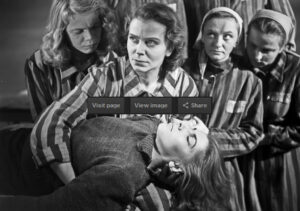
This Polish war movie launched the Holocaust theme in cinema. The documentary “The Last Stage” was made by a former inmate of the Auschwitz-Birkenau Nazi death camp, Wanda Jakubowska. The scenes shown in the film were based on the director’s personal memories or stories she heard. Indeed, Jakubowska herself managed to survive the hell of the camp in privileged conditions, on a farm near Auschwitz. “The Last Stage” shows the terrible fate of female prisoners and the unimaginable camp reality: the omnipresence of violence, death and the collapse of human dignity. Jakubowska’s film set the canon of Holocaust storytelling around the world, and all later films on the subject refer to this image, especially in scenes of collective roll call. The leading roles were played by Aleksandra Slaska, Barbara Drapinska, Barbara Rachwalska, Antonina Gordon-Górecka and Alina Janowska.
“The Last Stage” received great international recognition, although one should not forget the propaganda elements very strongly emphasized in the film. Communism is drawn here as the only hope for the future, and acting in the communist resistance is read as one of the greatest advantages. It is worth emphasizing the attention to the factual side of the film: the shooting was done in Auschwitz, and the actresses appeared in authentic camp striped uniforms.
3. “Forbidden Songs” (“Zakazane piosenki”), 1946

The first Polish movie made after World War II and at the same time a work commemorating wartime Warsaw. “Forbidden Songs” by Leonard Buczkowski, starring Danuta Szaflarska and Jerzy Duszynski, is a story about the fate of one Polish family during the difficult time of the German occupation. The story was told through popular wartime melodies, the title “forbidden songs,” facilitating Poles’ survival of gehenna. These are songs performed by street bands, which, as it were, relate to the audience the course of events from the September defeat (Dnia pierwszego września, roku pamiętnego…”) to the liberation of the capital (“Serce w plecaku”). Polish songs are juxtaposed here with German musical motifs, especially the ubiquitous “Heili, heilo!” anthem.
The screenplay for “Forbidden Songs” was written by Ludwik Starski, a famous pre-war filmmaker who had, among other things, one of the biggest hits of Polish comedy of the twentieth century: “The Floor Above.” In addition to authentic songs from the occupation period, the film will also hear melodies specially written for the film, such as “Warszawo ma…”.
4. “Border Street” (“Ulica Graniczna”), 1948

A touching Polish war movie directed by Aleksander Ford: “Border Street.” This is a story about the Holocaust as seen through the eyes of children. The little heroes of the story live in one Warsaw tenement house on Border Street. After the outbreak of World War II and the establishment of a ghetto in the capital, Jadzia’s father, Dr. Białek tries to hide his Jewish roots. Unfortunately, the truth soon comes out, and Fredek’s parents sign the volkslist and occupy his apartment. The children observe the various attitudes of adults toward war and moral choices.
“Border Street” is a movie that boldly tackled not only the Holocaust, but also complicated Polish-Jewish relations. For this reason, its realization was difficult. The script was written by Ford in collaboration with Ludwik Starski and Jan Fethke. Despite clear flaws, especially within the unfortunate casting of some actors from pre-war comedies in dramatic roles, the scenes showing the Warsaw Ghetto uprising, especially the death of the tailor Liberman (Wladyslaw Godik), are especially noteworthy. Also impressive is the music, whose Jewish themes were composed by Henoch Kon. The film starred Maria Broniewska, Tadeusz Fijewski, Stefan Srodka, Jerzy Zlotnicki and Mieczysława Ćwiklińska, among others.
5. “Kanal” (“Kanał”), 1956

A masterpiece of the Polish Film School, Andrzej Wajda’s “Kanal” depicts the tragic fate of young participants in the Warsaw Uprising. The film is set on the 56th day of the uprising against the German occupiers, at the end of September 1944. The company of Lieutenant Zadra (Wienczyslaw Glinski) is about to make its way through the sewers from Mokotow to Srodmiescie. During the march, the unit splits up. The wounded Korab (Tadeusz Janczar) is led by the liaison officer Stokrotka (Teresa Iżewska), who is in love with him. The film is based on a short story by Jerzy Stefan Stawinski.
“Kanal” was initially rejected by Polish audiences due to the deheroization of the insurgents, but over time became known as one of the most important Polish films. The picture was awarded the Silver Palm at the Cannes Festival, ex aequo with Ingmar Bergman’s “The Seventh Seal.” Wajda’s wartime film has clear inspirations from French existentialism and still impresses viewers today.
6. “Eroica”, 1957

Another outstanding Polish war movie – “Eroica” by Andrzej Munk. It’s made up of two novellas: “Scherzo alla polacca,” set during the Warsaw Uprising, and “Ostinato lugubre,” the action of which takes place in a German Oflag, where Polish soldiers taken prisoner during the September campaign are held. The protagonist of the first part of the film is a certain Dzidziuś Górkiewicz (played by Edward Dziewoński), who, initially skeptical of the uprising, eventually undertakes a very dangerous reconnaissance mission. In turn, the second war episode, extremely bleak in tone, shows Polish soldiers in Nazi captivity on the verge of a nervous breakdown. Their only hope is the legend of the escaped Lieutenant Zawistowski (Tadeusz Lomnicki).
“Eroica” was a response to Wajda’s “Kanal,” provoking a discussion of Polish heroism and the elements of any war that are silenced by the official narrative: human weakness, breakdown and the desire for normalcy. Unlike the director of “Ashes and Diamonds,” Munk uses irony and grotesque instead of romanticism. In turn, the film’s title is a reference to Ludwig van Beethoven’s Third Symphony.
7. “Westerplatte Resists” (“Westerplatte”), 1967
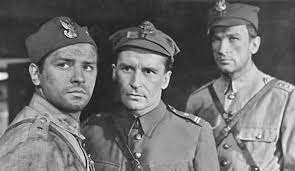
A movie showing the course of the dramatic seven-day battle at Westerplatte in September 1939, the picture of that very title directed by Tadeusz Różewicz. The screenplay was written by Jan Józef Szczepański. The film shows the heroic struggle of Polish soldiers under the command of Major Henryk Sucharski against the German invaders, attacking from the sea and from the land. The picture’s plot revolves around the conflicting attitudes of the two garrison commanders: the rational Sucharski (played by Zygmunt Hübner), who wants above all to save the soldiers, and his deputy Captain Franciszek Dąbrowksi (Arkadiusz Bazak), who wants to preserve the symbol of Westerplatte as a spearhead of the national fight against the enemy until the end. Pragmatism versus romanticism are the two ideological paths of Polish postwar patriotism, and the filmmakers have very aptly outlined them in the film.
“Westerplatte Reists” is a Polish war film showing the horror of direct combat with the enemy and the feelings that accompany it: fear, hope, anger and rage. The picture has a paradocumentary character. It begins and ends with a motif of silence – at first heralding the growing danger and, in the finale, capitulation.
8. “How I Unleashed World War II” (“Jak rozpętałem II wojnę światową”), 1970
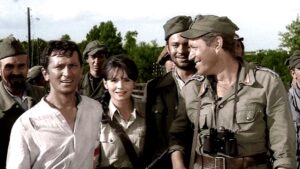
A Polish movie about the war – albeit a comedy one: “How I Unleashed the Second World War”, directed by Tadeusz Chmielewski and starring Marian Kociniak in an unforgettable role. Franek Dolas, a private in the Polish army, wakes up on a train after a lavish party. One carelessly fired shot… and the war is ready. The film shows the hilarious adventures of the hero in various wartime circumstances. In three parts of the movie we have the opportunity to follow the adventures of Frank Dolas in a prisoner of war camp, as well as in several European countries and even in Africa. Everywhere the savage soldier gives the enemy a hard time, and at the same time reveals the national vices of individual nations.
The movie “How I Unleashed World War II” was based on Kazimierz Slawinski’s 1967 novel “The Adventures of Canon Dolas“. The film gained unheard-of popularity, eight and a half million viewers saw it in the cinema, and today it belongs to the classics, adored and often repeated on various TV stations.
9. “H.M Deserters”, 1986
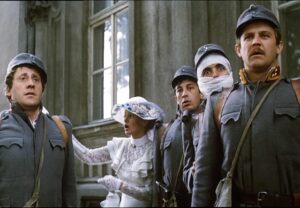
A popular comedy with a war theme – “C. K. Deserters” directed by Janusz Majewski and based on the novel by Kazimierz Sejda. The film is set at the end of World War I. In the barracks of the army of the Austro-Hungarian Empire, a new commander is trying to introduce his order. Meanwhile, a certain Kania, or Jan Kanowski (played by Marek Kondrat), along with several comrades, decide to desert the army. His company includes Hungarian Lajos Benedek (Zoltan Bezeredi), Jewish tailor Moryc (Wiktor Zborowski), Chudej, a Czech printer (Robert Koltai) and Italian prisoner of war Giuseppe Baldini (Jacek Sas-Ukrynowski). The men intend to get the funds they need by blackmailing the brothel’s clients.
“C.K. Deserters” is a movie made in 1986 and was read parabolically: as a costume of the oppressive communist system and rebellion against it. Similarly, the end of the Austro-Hungarian monarchy in the finale was seen as an allusion to the imminent collapse of communism in the Eastern Bloc countries.
10. ”The Gateway of Europe”, 1999
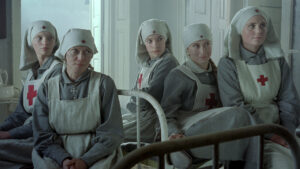
A very interesting item in Polish war cinema: “The Gateway of Europe”, directed by Jerzy Wojcik. The movie is set at the end of World War I, in 1918, in the eastern borderlands. It is a picture that is part of the de-legitimization of Polish history in Polish cinema after 1989. Three Polish nurses are assigned to work in a field hospital in the eastern territories of the former Republic. Soon the Bolsheviks arrive at the building, and the encounter with their bestiality exposes to the inexperienced girls all the horror of war and the methods of Soviet Russia.
“The Gateway of Europe” won three Golden Orlys and two Golden Lions. Noteworthy are the excellent acting performances: Alicja Bachleda-Curus as Zosia, with whom the Bolshevik commander falls in love, as well as Kinga Preiss, Agnieszka Sitek and Agata Buzek. Witold Sobociński’s superb cinematography was especially appreciated. The film was based on Melchior Wańkowicz’s novella “Hospital in Cichieniczach”, and the historical events underlying the picture were the battles between General Dowbor-Musnich’s I Corps and the Red Guards.
Polish war films
11. “All that Really Matters” (“Wszystko, co najważniejsze”), 1992
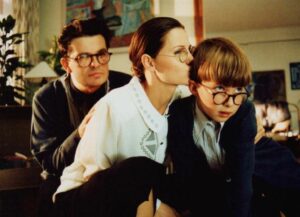
A deserving Polish war film based on the dramatic biography of Polish poet and novelist Aleksander Wat and his wife Ola. After the outbreak of World War II, Wat (played by Krzysztof Globisz), along with his wife (Ewa Skibińska) and little son, save themselves by escaping to Lviv. Soon the man is arrested by the NKVD, and Ola and Andrzej (Adam Siemion) are sent to a gulag in Kazakhstan. Thus begins the real wartime ordeal of the woman and her son….
“All that Really Matters”, a film awarded four Golden Lions, is a picture made with the utmost care for factual truth. For this reason, the characters appear under authentic names, and Wat himself approved the whole thing after production. The film deals with the difficult experiences of Poles in the eastern borderlands, especially prisoners of Soviet gulags, which were passed over in silence during the communist period. It shows that in the face of border experiences, interpersonal solidarity is determined by the simplest values and a fundamental sense of morality, not by class or political divisions.
12. “Demons of War” (“Demony wojny według Goi”), 1998
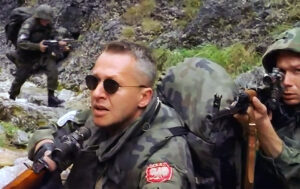
A Polish film showing the tragic civil war in the Balkans in the 1990s. The protagonists of Władysław Pasikowski’s “Demons of War” are Polish soldiers from the UN peacekeeping force, who helplessly watch the genocide being carried out before their eyes. When, against orders, they intervene in a conflict between police officers and the local population, the commander, Major Keller (Boguslaw Linda), is ordered to punitively return to the country. Major Kusz (Tadeusz Huk) arrives in his place, but soon they all embark on a dangerous rescue operation in the mountains, where a Norwegian helicopter is stuck. The operation may end in a serious scuffle, as these are areas controlled by a dangerous Serbian villain.
The Golden Duck Award-winning film starred a whole plethora of Polish actors. In addition to the aforementioned leading roles, “Demons of War” starred Olaf Lubaszenko, Zbigniew Zamachowski, Artur Żmijewski, Mirosław Baka, Bartłomiej Topa, Zbigniew Zapasiewicz, Aleksandra Nieśpielak.
13. “A Farewell to Maria” (“Pożegnanie z Marią”), 1993
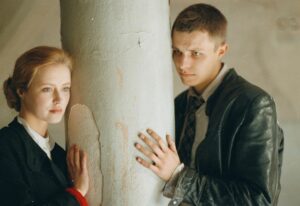
“Farewell to Maria” by Filip Zylber is a loose film adaptation of Tadeusz Borowski’s famous 1948 short story. The picture is set in 1943 in occupied Warsaw. Tadeusz, a young poet, works for a trucking company. Its owner, in exchange for money, helps Jews escape from the ghetto. One day, a young girl, Sara, who catches the eye of a Polish policeman Cieslik, manages to escape from there. The man, in exchange for keeping her origins a secret, demands that she become his mistress. Meanwhile, Tadeusz, aware of the horror unfolding around the war, decides to marry his fiancée Maria.
“Farewell to Maria” stars Marek Bukowski, Agnieszka Wagner, Katarzyna Jamróz and Slawomir Orzechowski. Unlike Borowski’s prose, the film exposes more than the drama of moral co-responsibility for the crimes the utter helplessness in the face of the evil of the Columbus generation, whose youth fell during this terrible time.
14. “Far from the Window” (“Daleko od okna”), 2000
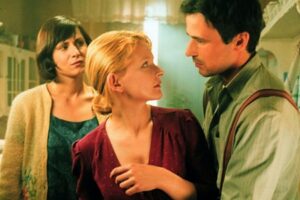
Affecting the emotions of the viewer psychological cinema, set during World War II: “Far from the Window” (see The Best World War II Movies). A young couple living in a small town hides a Jewish woman, Regina (Dominika Ostałowska), in their home. The woman has to be very careful that no one notices any traces of her presence. So she can’t go near the titular window, which risks denouncing everyone and a death sentence for all three of them. Soon Jan (Bartosz Opania) starts an affair with Regina. His wife Barbara (Dorota Landowska), when she finds out about everything, is shocked. However, when she realizes that the Jewish woman is pregnant, she decides to pretend in front of her neighbors that she is expecting a baby.
Jan Jakub Kolski’s movie is based on a short story by Hanna Krall. The screenplay was written by Cezary Harasimowicz. The picture touches on the subject of the Holocaust, Polish-Jewish relations and the dramatic moral choices that war can force a person to make.
15. “The Pianist” (2002)

Roman Polanski’s three Oscar-winning “The Pianist” is a highly emotional war movie. The film tells the story of the occupation fate of Władysław Szpilman, a Polish music composer with Jewish roots. The famous pianist lost his entire family in tragic circumstances: they were all deported from the Warsaw ghetto to a death camp. He miraculously managed to survive and hide first after the liquidation of the ghetto and then after the Warsaw Uprising in the ruins of the city. This was possible thanks to the help of friends, as well as a German officer, Captain Wilm Hosenfeld. The role of Szpilman was superbly played by Adrien Brody, who won an American Academy Award for his performance. The Oscar also went to Roman Polanski for best director and Ronald Harwood for best adapted screenplay.
“The Pianist” is an extremely personal work in the filmography of Polanski, who himself was in the Krakow ghetto as a child and was saved from the Holocaust. Although the production is international, Polish accents are clearly dominant, not only because of the main character and his story, but also because the shooting was done in Warsaw, and many Polish filmmakers worked on the film. Elements such as Wojciech Kilar’s music, Pawel Edelman’s cinematography and Alan Starski’s production design can be mentioned here.
16. “Katyn” (“Katyń”), 2007

Another personal Polish war movie: Andrzej Wajda’s “Katyn.” The director had long wanted to make this picture because of the collective memory and the unprocessed trauma of national history, but also because of his own roots. This is because Wajda’s father was a prisoner in the Kozielsk camp and was killed in Katyn. The film depicts events from the perspective of two women: the wives of Polish soldiers. They are Anna (Maja Ostaszewska), the spouse of Rotmistrz Andrzej (Artur Żmijewski), and Róża (Danuta Stenka), the wife of a general (Jan Eglert). The husbands of both heroines end up in Soviet captivity, and they lose contact with them and for many years cannot find out what happened to them.
“Katyn” by Wajda is an extremely important film, with which the director bore witness to the terrible crime committed by the Soviets against tens of thousands of Polish officers in 1940. Thanks to such a popular form as cinema, these events have become part of the common historical consciousness in the world. In turn, the construction of the film reflects what was happening in the PRl around these facts, namely the mechanisms of the Katyn lie. “Katyn” won an Oscar nomination and seven Golden Eagles, among other awards.
17. “In Darkness”, 2011

This film, although an international co-production, is on our list of Polish war cinema. “In Darkness” by Agnieszka Holland is not the first picture in the work of the Polish director that touches on the Holocaust. Already the internationally acclaimed “Europa Europa” touched on this issue. “In Darkness” is a story based on facts: the story of the rescue of a group of refugees from the ghetto in Lviv. The Jews survived thanks to the help of Leopold Socha (Robert Więckiewicz), once a thief, who, initially tempted by the prospect of making money, decided to get involved in hiding them in the sewers of the city.
The Oscar-nominated film “In Darkness” is the director’s courageous voice in the discussion of Polish anti-Semitism. Holland shows that it is an incredibly complicated phenomenon, the specifics of which perhaps only the Poles themselves can understand – for verbalized resentment rarely turns into concrete actions, and even more, it cannot exclude true heroism. In turn, at the center of this story is a profound humanistic message.
18. “Warsaw’44” (“Miasto 44”), 2014

Jan Komasa’s famous movie about the Warsaw Uprising – “City 44”. It is a cinematic reconstruction of the insurrection that broke out in Warsaw on August 1, 1944. The film depicts these events through the prism of the experiences of several young characters: Stefan (Jozef Pawlowski) and two girls in love with him: Alicja (Zofia Wichłacz) and Kama (Anna Próchniak). The director outlines the context of the uprising, its enthusiastic beginning and tragic end. In the foreground, however, are the personal experiences of the Columbuses – young people thrown into the vortex of great history and trying to tame it at all costs, saving their feelings and dignity.
“City 44” aroused a lot of controversy due to the director’s peculiar style, combining traditional narrative with modern elements, for example, rock music, music video aesthetics or solutions known from horror cinema. However, many scenes are memorable for their striking realism, such as the slaughter of Wola. Komasa also made “Warsaw Uprising” (2014), an innovative film consisting of edited authentic footage from 1944.
19. “Stones for the Rampart” (“Kamienie na szaniec”), 2014
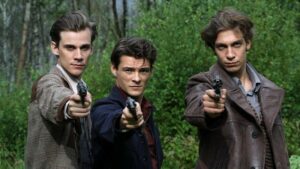
Aleksander Kaminski’s book on which many generations of Poles were raised – “Stones for the Rampart” (1943) – was filmed in 2014 by Robert Glinski in a truly youthful spirit. The compelling, fact-based story of Zoska, Rudy and Alek – three friends from the “Zoska” battalion of the Grey Regiments – is a tale of the incredible courage and sacrifice of the younger generation in the fight against the German occupiers. The filmmakers tried to make the characters as contemporary as possible and adapt them to the character of today’s young generation. The leading roles were played by Tomasz Ziętek, Marcel Sabat and Kamil Szeptycki. The director dedicated the film to his mother, who was a nurse in the “Zoska” battalion during the war.
20. “Hatred” (“Wołyń”), 2016
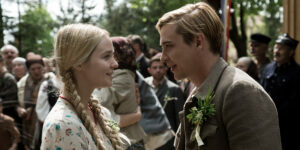
A gripping Polish war film – “Hatred” directed by Wojtek Smarzowski. It is a picture telling the story of the slaughter of the Polish borderland population by Ukrainian UPA units in the summer of 1943. The film’s plot begins just before the outbreak of World War II, in a small village in eastern Poland. Zosia Głowacka (Michalina Łabacz) marries a wealthy Polish farmer, Maciej Skiba (Arkadiusz Jakubik), against her will. The girl is in love with a young Ukrainian, Petro (Vasili Vasylyk). When Zosia’s husband is mobilized into the army and heads to the front, she tries to cope alone with the farm and the two children of the man from her first marriage. Meanwhile, a terrible history seeps into the village: the Soviet occupation, then the German occupation and finally the UPA.
“Hatered” is a film that reconstructs an extremely painful episode of Polish-Ukrainian relations. In it, Smarzowski tries to outline the broader context of the tragic events, reaching back to the pre-war realities of coexistence in one area between several nations. He does not draw simple divisions, but also does not shy away from factual concreteness and its terrible meaning.
